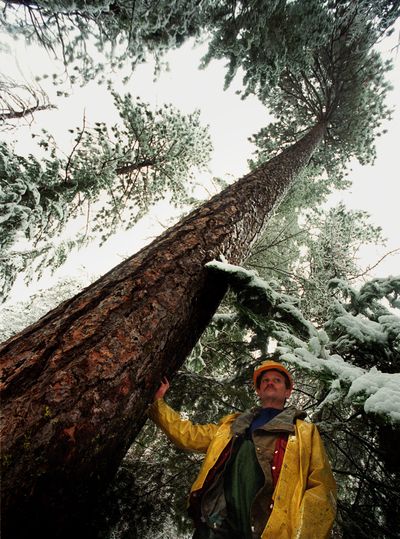Forest has ‘too many trees’
Coalition hopes to thin Colville National Forest

Can cutting trees help save a forest?
In northeastern Washington, a broad coalition of loggers, environmental groups, government officials and others think so. They’ve put together a forest restoration grant proposal that would step up timber harvests in the Colville National Forest over the next 20 years.
The grant request seeks $31 million for extra projects in the forest. The work would create an estimated 530 full- and part-time jobs in Stevens and Ferry counties over the two decades.
Most of the restoration logging is aimed at thinning dense stands of trees on the 1.1 million-acre forest. The tightly packed trees are the legacy of decades of fire suppression in the Colville National Forest, as well as past high-grade logging practices that cut the valuable timber and left the rest.
“You’ve got thickets of small-diameter trees that are 50, 60 or 70 years old,” said Mike Petersen, executive director of the Lands Council, a Spokane conservation group. “They’re choked, and they’re unnatural.”
Better spacing would reduce the risk of disease, insect attacks and high-intensity wildfires. Open stands would also help the trees weather the effects of climate change, which is expected to bring hotter, drier summers to the region.
“Having trees is a beautiful thing,” said Russ Vaagen, vice president of Vaagen Brothers Lumber Co. “But when you have too many trees, you’ve got a forest that’s going to fall in on itself. It’s like any overpopulation situation.”
Petersen and Vaagen are part of the Northeast Washington Forestry Coalition, an 8-year-old endeavor to find common ground on forest management. The coalition includes the timber industry, conservationists, local business owners and others.
Coalition members wrote the grant proposal in cooperation with the Colville National Forest, the Confederated Tribes of the Colville Reservation and the Washington Department of Natural Resources. Improving the vigor of trees in the national forest will benefit the tribe and the state, which own neighboring lands.
In late February, the $31 million grant request received a green light from the Forest Service’s Region 6, which covers Washington and Oregon. Now, the proposal heads to Washington, D.C., to compete for funding with restoration projects submitted by other national forests. A decision is expected in May.
The close collaboration by diverse parties has produced “what we feel is a highly competitive proposal,” said Laura Jo West, supervisor for the Colville National Forest.
If the proposal is funded, the Colville National Forest would harvest an additional 210 million board feet of timber over the next 20 years. In recent years, the forest’s annual harvest has averaged between 35 million and 60 million board feet of timber.
The 210 million board feet equates to about 42,000 truckloads of logs. The timber harvested would be a good fit for local sawmills that have switched to processing small-diameter timber, the Lands Council’s Petersen said.
All the material could be processed in the region as lumber or plywood, or chips or sawdust for pellet, pulp or biomass plants, Vaagen said.